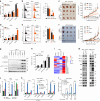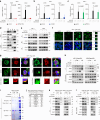Disruption of DNA-PKcs-mediated cGAS retention on damaged chromatin potentiates DNA damage-inducing agent-induced anti-multiple myeloma activity
- PMID: 38877108
- PMCID: PMC11300664
- DOI: 10.1038/s41416-024-02742-3
Disruption of DNA-PKcs-mediated cGAS retention on damaged chromatin potentiates DNA damage-inducing agent-induced anti-multiple myeloma activity
Abstract
Background: Targeting DNA damage repair factors, such as DNA-dependent protein kinase catalytic subunit (DNA-PKcs), may offer an opportunity for effective treatment of multiple myeloma (MM). In combination with DNA damage-inducing agents, this strategy has been shown to improve chemotherapies partially via activation of cGAS-STING pathway by an elevated level of cytosolic DNA. However, as cGAS is primarily sequestered by chromatin in the nucleus, it remains unclear how cGAS is released from chromatin and translocated into the cytoplasm upon DNA damage, leading to cGAS-STING activation.
Methods: We examined the role of DNA-PKcs inhibition on cGAS-STING-mediated MM chemosensitivity by performing mass spectrometry and mechanism study.
Results: Here, we found DNA-PKcs inhibition potentiated DNA damage-inducing agent doxorubicin-induced anti-MM effect by activating cGAS-STING signaling. The cGAS-STING activation in MM cells caused cell death partly via IRF3-NOXA-BAK axis and induced M1 polarization of macrophages. Moreover, this activation was not caused by defective classical non-homologous end joining (c-NHEJ). Instead, upon DNA damage induced by doxorubicin, inhibition of DNA-PKcs promoted cGAS release from cytoplasmic chromatin fragments and increased the amount of cytosolic cGAS and DNA, activating cGAS-STING.
Conclusions: Inhibition of DNA-PKcs could improve the efficacy of doxorubicin in treatment of MM by de-sequestrating cGAS in damaged chromatin.
© 2024. The Author(s), under exclusive licence to Springer Nature Limited.
Conflict of interest statement
The authors declare no competing interests.
Figures






References
MeSH terms
Substances
LinkOut - more resources
Full Text Sources
Medical
Research Materials

